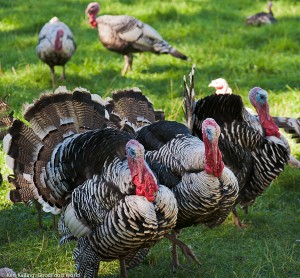
Thanksgiving is the biggest food holiday of the year; though Christmas and Easter aren’t far behind! In the cook/bake/eat marathon that is going on this week, we need to take a pause.
We all have much to be grateful for, including the friends we have made along the road. At GoodFood World, we want to say “thanks” to old friends, new friends, and friends we have yet to meet! All the best of Thanksgiving to you!
We also need to recognize that there are many millions of people for whom good food is a luxury. In fact, it’s getting to be a stretch for even middle income families. More consumers are looking for safe, healthy and nutritious food, and yet “purists” with fat pocket books are paying huge sums for overly-hyped birds like these, which sell for $14 a pound – that’s $350 for a 25 pound turkey:
Slow grown, free range, fed on certified organic pasture with grasses, native weeds, seeds, nuts, wild flowers, and natural vegetation, and with 24-hour access to abundant pure, mineral-rich, filtered water. No medications, hormones, steroids, antibiotics, additives, pesticides, herbicides, or artificial or commercial fertilizers; no animal by products or blood; no arsenicals; and no artificial grow lights.
Wild flowers??? Puh-leeze!!

All turkeys – wild turkeys and the broad-breasted white or the dozen or so “heritage” breeds grown domestically today – are the same species (Meleagris gallopavo).
Farmers produce nearly 250 million turkeys every year of all kinds for the American table; 99.9% of those are the broad-breasted white breed sold in supermarkets across the country. Around 25,000 heritage breed turkeys are raised on small farms and sold directly to consumers or through specialty markets.
If you live in Wisconsin or Minnesota, you are more likely to have a wild turkey on your dinner table than a “heritage” breed; in 2009, more than 70,000 wild turkeys were killed during the states’ spring and fall hunting seasons. (1)(2)
Benjamin Franklin admired the wild turkey for its boldness and ability to forage for itself. In the 230+ years since, consumers have come to admire the domestic turkey for its ability to grow fat and large breasted, fast! The Broad-Breasted White grows to an average of 32 pounds in just 18 weeks. So fast that the bird develops a variety of health problems including leg and joint disorders, lameness, heart disease, and weakened immune systems.(3)

Turn these birds out from their factory farms and they’d certainly die. They can’t run – in fact, they can barely walk – or fly. They depend on large quantities of high protein food and hormones to support rapid grown. And – as a final insult – even if allowed the opportunity to mate, they couldn’t reproduce.
Consumers who want pasture-raised heritage breed turkeys are looking for birds that are well cared for, grow slowly, and have flavorful meat. Unfortunately they are expensive to produce.
Domestic turkeys are tough animals to raise. Poults (young turkeys) are fragile birds. They don’t tolerate heat or cold very well, they start out needing a very high protein diet and, until they are about 10 weeks old, they are at risk from predators while in the field. The heritage breeds are more robust than the broad-breasted whites and, once they are large enough to fend for themselves outdoors, they grow slowly, taking 24 to 30 weeks to reach market weight.

At the same time, growing demand is driving up the price. Dean and Deluca – the high-end food market – offers heritage turkeys for $90 (for a 10-pound bird) to $125 (14 pounds). Also available at D&D is the D’Artagnan wild turkey – “farm-raised from the original wild breed” – for $14 per pound. That’s a whopping $168 for a 12-pound bird.
Compare that to QFC, a Seattle chain of supermarkets, which this week offered 24-pound turkeys for under $10 with the purchase of $25 worth of groceries.
While pastured, free-range, antibiotic- and hormone-free, naturally raised heritage turkeys may more closely resemble the turkeys our great grandparents ate; they are being priced out of the reach of the average American.
Short of partnering with a turkey hunter or raising a couple of birds in the back yard, consumers looking for alternatives are buying from farmers like Louis Sukovaty who sell direct. Every year, Crown S Ranch raises several hundred organic turkeys, both broad-breasted whites and heritage breeds. And they are a bargain at $6 or $7 a pound.
We shouldn’t just eat “corporate turkeys.” What we should do is support the small farmer who is doing his or her best to raise a good bird and sell it at a reasonable price.
Give thanks for your local farmer, and enjoy your dinner!
P.S. For those of you who prefer not to eat meat for the holiday, try your hand at Tofu Turkey. Here’s a recipe for a vegetarian holiday dinner from our Health Living correspondent, Ina Denburg.
________________________________________
More information:
(1) Minnesota wild turkey harvests: http://files.dnr.state.mn.us/recreation/hunting/turkey/fallturkey2009_harvest.pdf, http://files.dnr.state.mn.us/recreation/hunting/turkey/springturkey2009_harvest.pdf
(2) Wisconsin wild turkey harvest: http://dnr.wi.gov/org/land/wildlife/hunt/turkey/harvsumm.htm
(3) Farm Sanctuary, Unnatural Breeding Techniques and Results in Modern Turkey Production, http://www.farmsanctuary.org/mediacenter/turkey_ai.html

